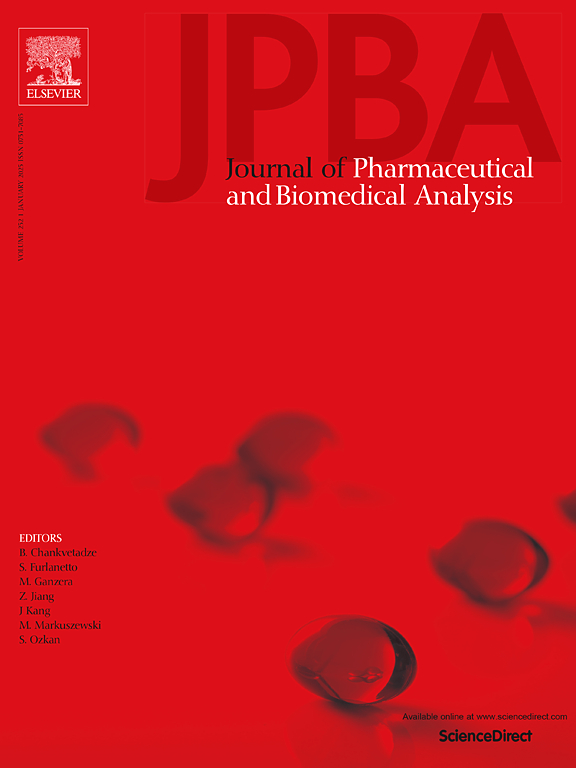复合基质中痕量博来霉素的定量分析:在体外化疗中的应用
IF 3.1
3区 医学
Q2 CHEMISTRY, ANALYTICAL
Journal of pharmaceutical and biomedical analysis
Pub Date : 2025-04-30
DOI:10.1016/j.jpba.2025.116927
引用次数: 0
摘要
博莱霉素是一种细胞毒性抗生素,由于其极极性、螯合特性、组分的异质性以及在电喷雾电离过程中形成多个带电物质的倾向,对基于质谱的分析提出了实质性的挑战。博莱霉素作为电化疗中使用的少数有效药物之一,量化痕量博莱霉素水平的能力对于评估治疗效果至关重要,通常需要超出现有分析方法能力的灵敏度。这种精确的量化将有助于评估电化疗的疗效,例如比较纳秒电脉冲与常规微秒电脉冲的体外效果。为了应对这些挑战,我们将细胞活力分析与强大的化学分析方法相结合。该方法采用固相萃取法制备样品,并结合HILIC-LC-MS/MS,获得了极高的灵敏度,LLOQ为0.075 µg/L,克服了分析物和基质的复杂性。虽然证实了纳秒脉冲(25 × 400 ns)与博来霉素联合使用可显著降低细胞存活率,但化学分析显示了差异,强调了电脉冲参数与药物作用之间复杂的相互作用。这些发现强调了进一步完善治疗方案和发展先进分析技术的必要性。本文章由计算机程序翻译,如有差异,请以英文原文为准。
Quantitative analysis of trace-level bleomycin in complex matrices: Application to in vitro electrochemotherapy
Bleomycin, a cytotoxic antibiotic, poses substantial challenges for mass spectrometry-based analysis due to its extreme polarity, chelating properties, heterogeneity of fractions, and propensity to form multiple charged species during electrospray ionization. As one of the few effective drugs used in electrochemotherapy, the ability to quantify trace levels of bleomycin is critical for evaluating treatment efficacy, often requiring sensitivity beyond the capabilities of existing analytical methods. Such precise quantification would facilitate the evaluation of electrochemotherapy efficacy, such as comparing the in vitro effects of nanosecond electric pulses with conventional microsecond pulses. To address these challenges, we integrated cell viability assays with a robust chemical analytical approach. This approach employed solid-phase extraction for sample preparation, combined with HILIC-LC-MS/MS, achieving exceptional sensitivity with LLOQ of 0.075 µg/L and overcoming analyte and matrix complexity. Although a significant reduction in cell survival was confirmed when combining nanosecond pulses (25 × 400 ns) with bleomycin, chemical analysis revealed discrepancies, underscoring the complex interaction between electric pulse parameters and drug action. These findings highlight the need for further refinement of treatment protocols and the development of advanced analytical techniques.
求助全文
通过发布文献求助,成功后即可免费获取论文全文。
去求助
来源期刊
CiteScore
6.70
自引率
5.90%
发文量
588
审稿时长
37 days
期刊介绍:
This journal is an international medium directed towards the needs of academic, clinical, government and industrial analysis by publishing original research reports and critical reviews on pharmaceutical and biomedical analysis. It covers the interdisciplinary aspects of analysis in the pharmaceutical, biomedical and clinical sciences, including developments in analytical methodology, instrumentation, computation and interpretation. Submissions on novel applications focusing on drug purity and stability studies, pharmacokinetics, therapeutic monitoring, metabolic profiling; drug-related aspects of analytical biochemistry and forensic toxicology; quality assurance in the pharmaceutical industry are also welcome.
Studies from areas of well established and poorly selective methods, such as UV-VIS spectrophotometry (including derivative and multi-wavelength measurements), basic electroanalytical (potentiometric, polarographic and voltammetric) methods, fluorimetry, flow-injection analysis, etc. are accepted for publication in exceptional cases only, if a unique and substantial advantage over presently known systems is demonstrated. The same applies to the assay of simple drug formulations by any kind of methods and the determination of drugs in biological samples based merely on spiked samples. Drug purity/stability studies should contain information on the structure elucidation of the impurities/degradants.

 求助内容:
求助内容: 应助结果提醒方式:
应助结果提醒方式:


